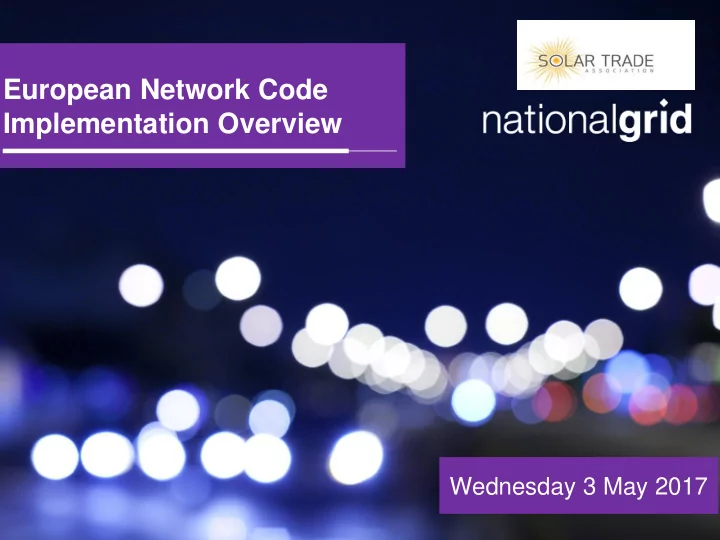

European Network Code Implementation Overview Wednesday 3 May 2017
EU Code Implementation Overview Background and purpose More detail on: Connection Codes – Requirements for Generators Operational Codes Balancing Codes Implementation Progress Get involved/Keep informed 2
European Network Code Implementation Overview Rob Wilson Technical Codes Development Manager
European 3rd package drivers 4
The key players in ENC Development 5
European Network Codes Development Process 6
What are the codes and what do they do? Establishes a platform for managing capacity and flow around the interconnected system to facilitate the setup of a single EU market Capacity Allocation Electricity Markets & Congestion Forward Capacity Balancing Allocation (“FCA”) Management Guideline (“CACM”) (“EBGL”) Harmonises the processes Transmission System Operators have to manage their systems, including system restoration System Operation (Transmission) System Emergency & Restoration Operation Guideline (“TSOG”) (“ER”) Sets consistent technical requirements across EU for new connections of user equipment (e.g. generation/interconnectors) Grid Demand Connection Requirements for High Voltage Direct Connection (Code) Generators (“RfG”) Current (“HVDC”) (“DCC”) 7
More detail on: EU Connection Codes
Overview of the EU Connection codes Requirements for Generators (RfG) Entry Into Force: 17 th May 2016 Applies to: New generation connections (800 Watts capacity and up) to Distribution and Transmission systems From: 17 th May 2018 onwards Demand Connection Code (DCC) Entry Into Force: 7 th September 2016 Applies to: New Transmission-connected Demand connections; and new equipment providing Demand Side Response From: 7 th September 2018 High Voltage Direct Current (HVDC) Entry Into Force: 29 th September 2016 Applies to: New Transmission-connected Demand connections,, and new equipment providing Demand Side Response From: 7 th September 2018 9
More detail on RfG – Generator Banding Technical requirements in RfG are arranged into x 4 Types based on a user’s connection voltage and MW capacity Type A - B requirements are close to a product standard Type C - D requirements need active user management GB levels will apply consistently across Scotland and England + Wales. The local TSO (NGET) will make a proposal for the levels - this is then ratified via industry consultation and regulatory approval Maximum RfG banding levels permitted for GB: Current GB Levels: Connection Generator SHET SPT NGET Type Capacity Size Voltage Small <10MW <30MW <50MW 800 W – 1 MW A < 110kV Medium 50-100MW 1 MW – 50 MW B < 110kV Large >10MW >30MW >100MW 50 MW – 75 MW C < 110kV D > 110kV 75 MW +
More detail on RfG – Requirements per Type Technical Requirements Type A Type B Type C Type D ● ● ● ● Operation across a range of frequencies ● ● ● ● Limits on active power output over frequency range ● ● ● ● Rate of change of frequency settings applied (likely to be at least 1Hz/sec) ● ● ● ● Logic interface (input port) to cease active power output within 5 secs ● ● ● Ability to automatically reduce power on instruction ● ● ● Control schemes, protection and metering ● ● ● Fault Ride Through requirements ● ● ● Ability to reconnect ● ● ● Reactive capability ● ● ● Reactive current injection ● ● Active power controllability ● ● Frequency response ● ● Monitoring ● ● Automatic disconnection ● ● Optional Black start ● ● Stable operation anywhere in operating range ● ● Pole slipping protection ● ● Quick resynchronisation capability ● ● Instrumentation and monitoring requirements ● ● Ramp rate limits ● ● Simulation models ● Wider Voltage ranges / longer minimum operating times ● Synchronisation on instruction 11 ● Enhanced Fault Ride through
More detail on: Transmission System Operation Guideline Rob Selbie EU Codes Development Manager
Overview of the EU System Operation codes Harmonises the processes TSO have to manage their systems, including system operation Transmission System Operation Guideline (TSOG): system security, operational planning and frequency management standards Operational Operational Load Security Planning Frequency • Data Exchange • Regional security Control & • System States coordination Reserves • System • Outage Management • coordination Operational • Adequacy agreements • Quality targets Emergency & Restoration Code (E&R) : Harmonisation of system defence and restoration procedures during severe events 13
So am I impacted? TSOs Generators More Distribution transparency New data Interconnectors Network in system exchange Facilitation of Operators operation requirements exchange of A/S New data Operational Including for Including exchange security distribution agreements for requirements analysis connected cross-border and outage SGUs Cross-border processes coordination processes responsibilities 14
More detail on: Electricity Balancing Guideline; TERRE
Overview of the European MARKET codes Pan-EU Balancing Harmonisation of Market Cross Zonal Capacity Energy Market Design & Settlement Reservation (CZC) • Development of pan-EU platforms • Harmonised Gate Closure Time for • Opens the possibility for TSOs to for the exchange of standard standard products reserve XB capacity for the • Harmonisation of ISP at Synchronous balancing energy products exchange of balancing energy • 6 year implementation period Area level • Co optimisation with market • Replacement Reserves (RR) • Harmonisation of imbalance timeframes • Manual Frequency Restoration arrangements (preference for single • TSOs to develop detailed Reserves (mFRR) imbalance pricing) methodologies • Specific products retained • Harmonisation of reserve procurement nationally arrangements Early Implementation – Project TERRE 16
Overview of the European Market codes TSOs: Access to a wider pool of flexibility EU Platforms procurement closer to real time Balancing Service Providers: New standard products; Access to EU market; Level playing field Balance Responsible Parties: Harmonised imbalance settlement; Imbalance Adjustment; More accurate price signals Interconnectors: Facilitation of exchange of A/S; More variability 17
Implementation Progress
ENC implementation approach (multiple interactions to manage!)
Recommend
More recommend